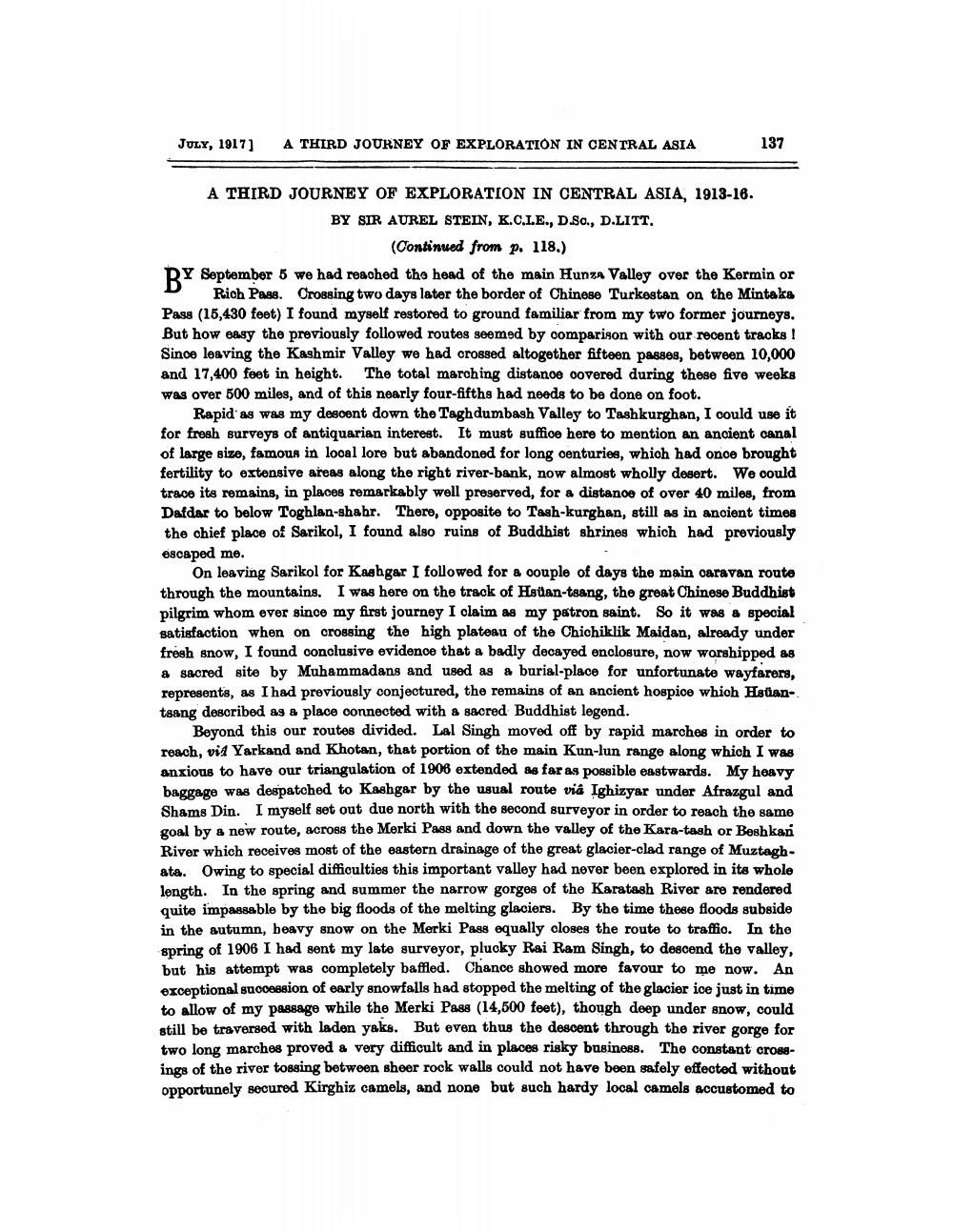________________
JULY, 1917] A THIRD JOURNEY OF EXPLORATION IN CENTRAL ASIA
137
A THIRD JOURNEY OF EXPLORATION IN CENTRAL ASIA, 1913-16. BY SIR AUREL STEIN, K.C.LE., D.SO., D.LITT.
(Continued from p. 118.)
BY
Y September 5 we had reached the head of the main Hunza Valley over the Kermin or Rich Pass. Crossing two days later the border of Chinese Turkestan on the Mintaka Pass (15,430 feet) I found myself restored to ground familiar from my two former journeys. But how easy the previously followed routes seemed by comparison with our recent tracks ! Since leaving the Kashmir Valley we had crossed altogether fifteen passes, between 10,000 and 17,400 feet in height. The total marching distance covered during these five weeks was over 500 miles, and of this nearly four-fifths had needs to be done on foot.
Rapid as was my descent down the Taghdumbash Valley to Tashkurghan, I could use it for fresh surveys of antiquarian interest. It must suffice here to mention an ancient canal of large size, famous in local lore but abandoned for long centuries, which had once brought fertility to extensive areas along the right river-bank, now almost wholly desert. We could trace its remains, in places remarkably well preserved, for a distance of over 40 miles, from Dafdar to below Toghlan-shahr. There, opposite to Tash-kurghan, still as in ancient times the chief place of Sarikol, I found also ruins of Buddhist shrines which had previously escaped me.
On leaving Sarikol for Kashgar I followed for a couple of days the main caravan route through the mountains. I was here on the track of Hsuan-tsang, the great Chinese Buddhist pilgrim whom ever since my first journey I claim as my patron saint. So it was a special satisfaction when on crossing the high plateau of the Chichiklik Maidan, already under fresh snow, I found conclusive evidence that a badly decayed enclosure, now worshipped as a sacred site by Muhammadans and used as a burial-place for unfortunate wayfarers, represents, as I had previously conjectured, the remains of an ancient hospice which Hstiantsang described as a place connected with a sacred Buddhist legend.
Beyond this our routes divided. Lal Singh moved off by rapid marches in order to reach, vid Yarkand and Khotan, that portion of the main Kun-lun range along which I was anxious to have our triangulation of 1906 extended as far as possible eastwards. My heavy baggage was despatched to Kashgar by the usual route via Ighizyar under Afrazgul and Shams Din. I myself set out due north with the second surveyor in order to reach the same goal by a new route, across the Merki Pass and down the valley of the Kara-tash or Beshkań River which receives most of the eastern drainage of the great glacier-clad range of Muztaghata. Owing to special difficulties this important valley had never been explored in its whole length. In the spring and summer the narrow gorges of the Karatash River are rendered quite impassable by the big floods of the melting glaciers. By the time these floods subside in the autumn, beavy snow on the Merki Pass equally closes the route to traffic. In the spring of 1906 I had sent my late surveyor, plucky Rai Ram Singh, to descend the valley, but his attempt was completely baffled. Chance showed more favour to me now. An exceptional succession of early snowfalls had stopped the melting of the glacier ice just in time to allow of my passage while the Merki Pass (14,500 feet), though deep under snow, could still be traversed with laden yaks. But even thus the descent through the river gorge for two long marches proved a very difficult and in places risky business. The constant crossings of the river tossing between sheer rock walls could not have been safely effected without opportunely secured Kirghiz camels, and none but such hardy local camels accustomed to




